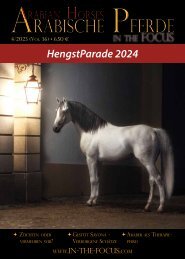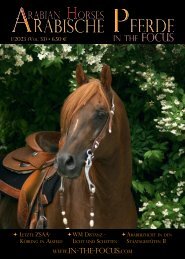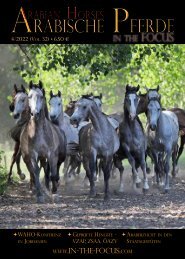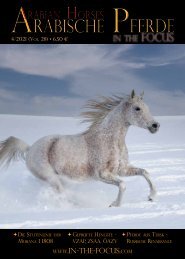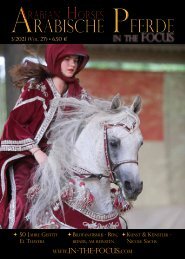Arabische Pferde IN THE FOCUS Nr. 3-2020 (Vol. 23) - public
Zeitschrift für Liebhaber und Züchter arabischer Pferde
Zeitschrift für Liebhaber und Züchter arabischer Pferde
Erfolgreiche ePaper selbst erstellen
Machen Sie aus Ihren PDF Publikationen ein blätterbares Flipbook mit unserer einzigartigen Google optimierten e-Paper Software.
The "Grand Old Dame"<br />
You can't talk about Arabian horses in Iran<br />
without introducing Mary Gharagozlou and<br />
her life's work. Born in 1927 as the daughter of<br />
Naqi Khan, a doctor who came from a long line<br />
of Persian landowners and statesmen from the<br />
Gharagozlou tribe, and the American Katherine<br />
Ladd, a librarian at the University of Baltimore,<br />
Mary had insights into two worlds - the Orient<br />
and Occident. She married Majid Bakhtiar, a<br />
Bakhtiari tribal leader, and became Iran's leading<br />
expert on arid farming. She worked tirelessly<br />
for the benefit of the nomadic tribes throughout<br />
Iran, lived with them and they paid her the<br />
greatest respect. For several years she was also<br />
head of the Iranian nomad ministry.<br />
It was an exciting, fascinating, but also difficult<br />
life, because she stood up for the nomads all<br />
her life, but the government was suspicious of<br />
them, so she ended up in prison at the one or<br />
the other occasion. When she married her husband<br />
Majid Bakhtiar, he had already inherited<br />
a stud from his father. Through him she got to<br />
know the Arabian horses in Iran, which were to<br />
become her great love and passion. Her life's<br />
work was then the registration of the Arabian<br />
horses in Iran in a studbook in order to have<br />
them recognized by the WAHO. She only succeeded<br />
in doing this thanks to her outstanding<br />
position of trust among the nomads, because<br />
here, as in other countries in the Middle East,<br />
the nomadic population was very skeptical<br />
of the government and was not always ready<br />
to provide information about their valuable<br />
horses or let them being branded as the WAHO<br />
demanded for identification. They feared this<br />
might be a government method of stealing<br />
their horses. In spite of all efforts on the part of<br />
Mary Gharagozlou, one or the other horse was<br />
"left out".<br />
Horse breeds in Iran<br />
Iran has been a multi-ethnic state for three millennia<br />
and this also applies to today's Islamic<br />
Re<strong>public</strong>, whose ethnic, cultural and religious<br />
diversity is often overlooked in the West. Many<br />
of the peoples come from nomadic tribes, some<br />
of these tribes have also bred horses. Therefore,<br />
several horse breeds are native to Iran, such as<br />
the Kurdish horse in northwestern Iran, on the<br />
border with Turkey, the Dareshuri horse in the<br />
central and southern Zagros Mountains, the<br />
Turkmen in northeastern Iran, on the border<br />
with Turkmenistan, the Caspian pony on the<br />
3/<strong>2020</strong> - www.in-the-focus.com<br />
Beispiel eines iranischen Pedigrees: Arras ist unter den ca. 300 Gründerpferden, die vom<br />
Asil-Club anerkannt wurden. "d.b." bedeutet Desertbred, "o.s." bedeutet "Original Strain". -<br />
Example of an Iranian pedigree: Arras is one of the ca. 300 foundation horses, that were accepted<br />
by the Asil Club. "d.b." means Desertbred, "o.s." means Original Strain.<br />
Caspian Sea and the Arabian horses ("Asil Iranians")<br />
in Khuzestan, a province in the south,<br />
bordering Iraq.<br />
The Iranians themselves recognize as "Asil Iranians"<br />
only those horses that are descended<br />
from the horse-breeding Arab nomadic tribes in<br />
Khuzestan, have a "strain name" and it must be<br />
known which Bedouin (or nomadic) tribe once<br />
used this strain because, as in other Arab countries,<br />
there were families known as the "owners<br />
of a strain" who have had bred that strain within<br />
that family for several hundred years.<br />
Unfortunately, there are numerous misunderstandings<br />
in the literature, also from wellknown<br />
authors, who have written about Persia<br />
and its horses. E.g. General Tweedie called<br />
the Kurdish horse the "Persian Arabian" and<br />
Judith Forbis also believed that the Dareshuri<br />
was the Arabian horse of Iran. This is not the<br />
case, because these breeds were not bred by<br />
the Arab nomadic tribes, but by Persian tribes.<br />
The Bakthiari, a Persian nomadic tribe, are an<br />
exception, as they had bought Arabian horses<br />
from some Arab tribes a long time ago and bred<br />
them according to the same strict principles - in<br />
some cases even stricter - than the Arabs themselves.<br />
The Arab nomads in Iran<br />
The Arab nomadic tribes of Iran live in the<br />
southwest on the border with Iraq (see red<br />
marking in the map page 7); they are parts of<br />
the Bedouin tribes Al Kamees, Al Kassir, Beni<br />
Lam, Mir and others. These tribes immigrated<br />
to Persia from Mesopotamia a long time ago,<br />
and have retained their Arab way of life, their<br />
principles of breeding and their religion. They<br />
also have maintained their "strains" and bred<br />
on with these lines.<br />
Racing with Asil Iranians was very popular<br />
until the French racing horses were imported to<br />
Iran. - Der Rennsport mit Asil Iranern war sehr<br />
beliebt, bis französische Rennaraber in den<br />
Iran importiert wurden.<br />
11<br />
The strains in Iran<br />
Table 1 (see p. 8) shows the number of Asil-Iranian<br />
horses and how they are distributed among<br />
the respective strains. There are currently 1213<br />
breeding animals that are recognized by the<br />
"Iranian Asil Association" as "Asil-Iranians" according<br />
to the above criteria.<br />
The largest tribe, Wadne Khersan, with over 400<br />
horses is striking. But this tribe is little known<br />
outside of Iran - so where does it come from?<br />
The Wadne Khersan tribe were brought to Persia<br />
with two Bedouin (nomadic) tribes, the Al<br />
Kassir and Mir Beduins. Originally, however, this<br />
strain comes from the Nedjd, as a description by<br />
Lewis Pelly, 1865, shows (see p. 13). In his book<br />
"A Journey to Riyadh in Central Arabia" he lists<br />
different horse tribes of the Nedjd: next to Saklawi<br />
Jedran, Koheilan Adjouz, Obayan Sherrak<br />
and Dahman Shahwan, he names the fifth of<br />
the most important tribes in the Nedjd Wadne<br />
Khersan!<br />
The second largest group in Iran are the Koheilan,<br />
followed by the Hamdani Semri, Obayan<br />
and Saglawi.<br />
Table 2 (see p. 12) shows which strains still exist<br />
in Syria, Iran, Bahrain, Saudi Arabia and<br />
Egypt. Syria has the greatest diversity of tribes,<br />
followed by Iran and Bahrain and finally Egypt<br />
and Saudi Arabia. This is also reflected in the<br />
latest scientific research into the genetics of<br />
these original populations: Syria, Iran, Bahrain<br />
and Saudi Arabia have high genetic diversity.<br />
This indicates great proximity to the origin of<br />
the breed. In Saudi Arabia, the number of (WA-<br />
HO-recognized) "desertbred Arabs" recorded<br />
in the studbook is rather low, which is why the<br />
diversity of tribes has also decreased. Egypt<br />
- which is not a country of origin - has a low<br />
genetic diversity and compared to the other<br />
populations a high homozygosity. This can be<br />
easily explained because Abbas Pascha only<br />
got a small "selection" from the actually existing<br />
gene pool of Saudi Arabia. These horses<br />
were selected according to his (beauty) ideal<br />
and so horses with other characteristics remained<br />
in Arabia. With this relatively small section<br />
of the gene pool, breeding was continued<br />
from then on, whereby the degree of inbreeding<br />
Zucht




